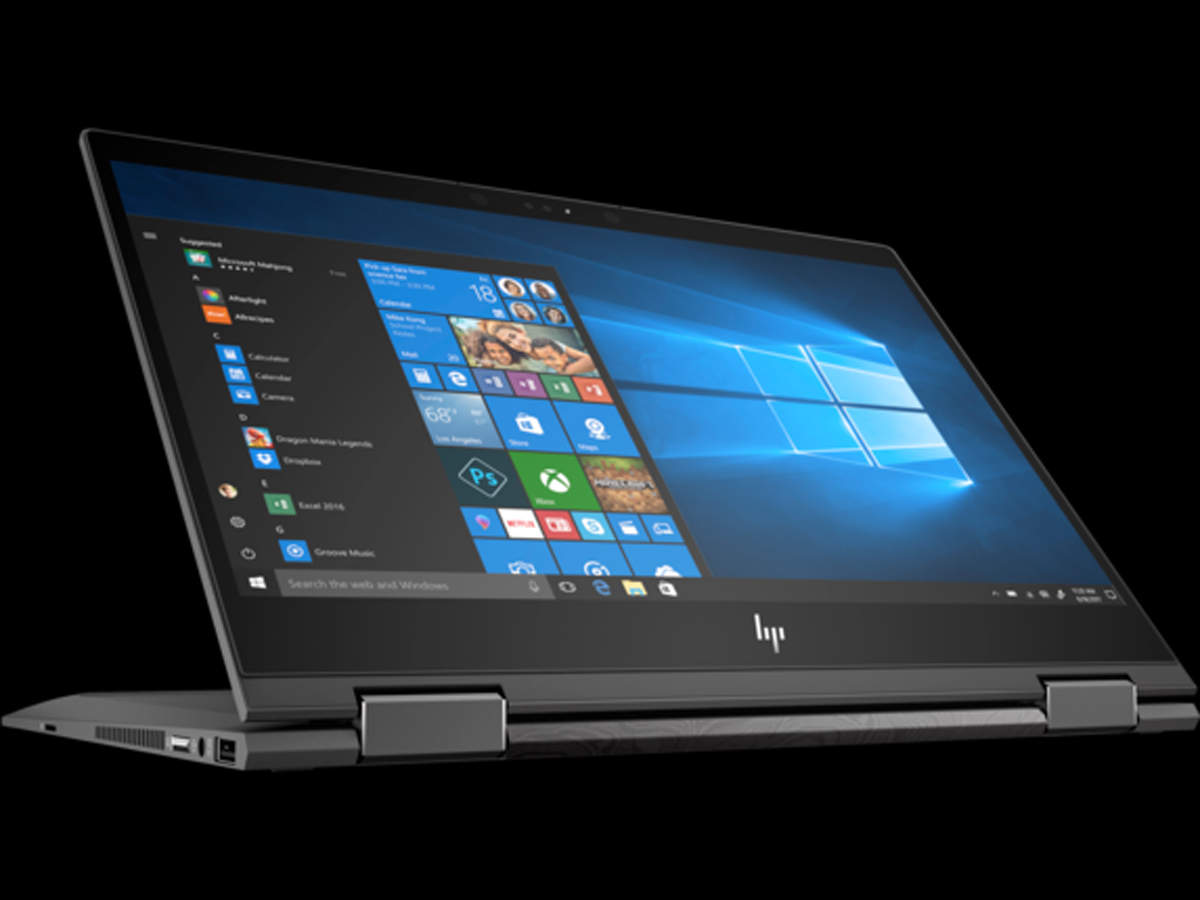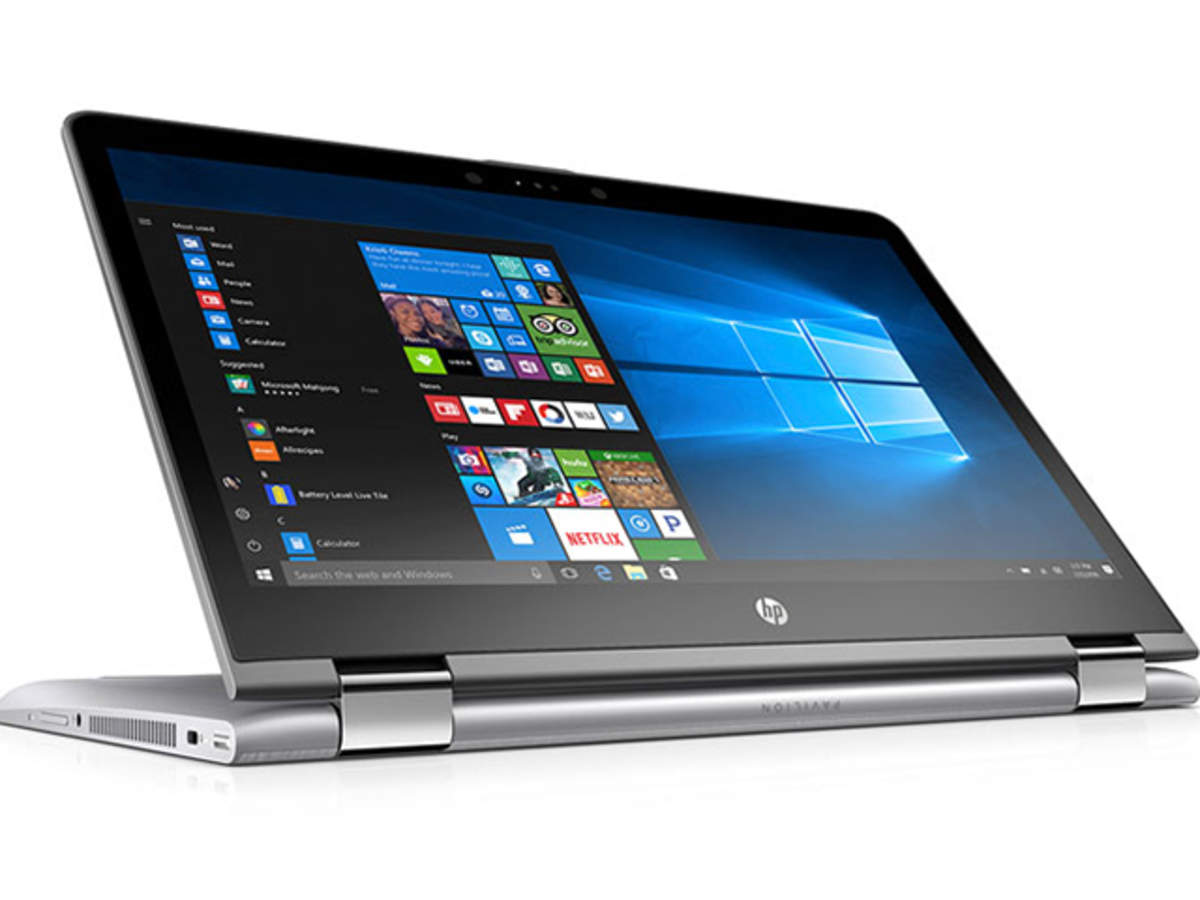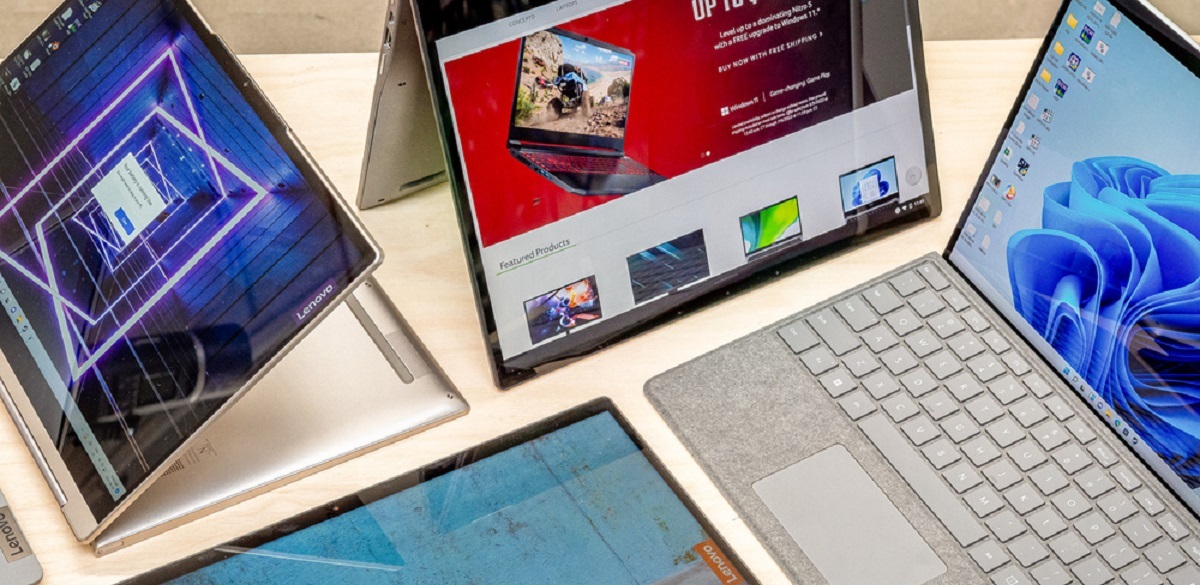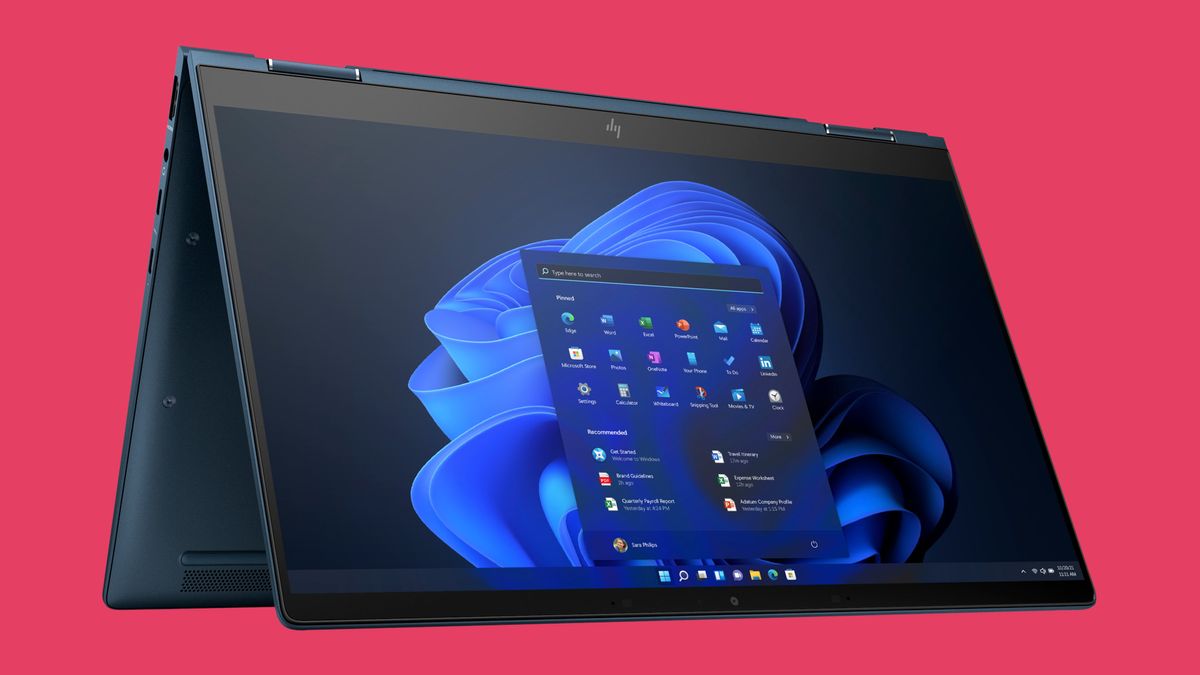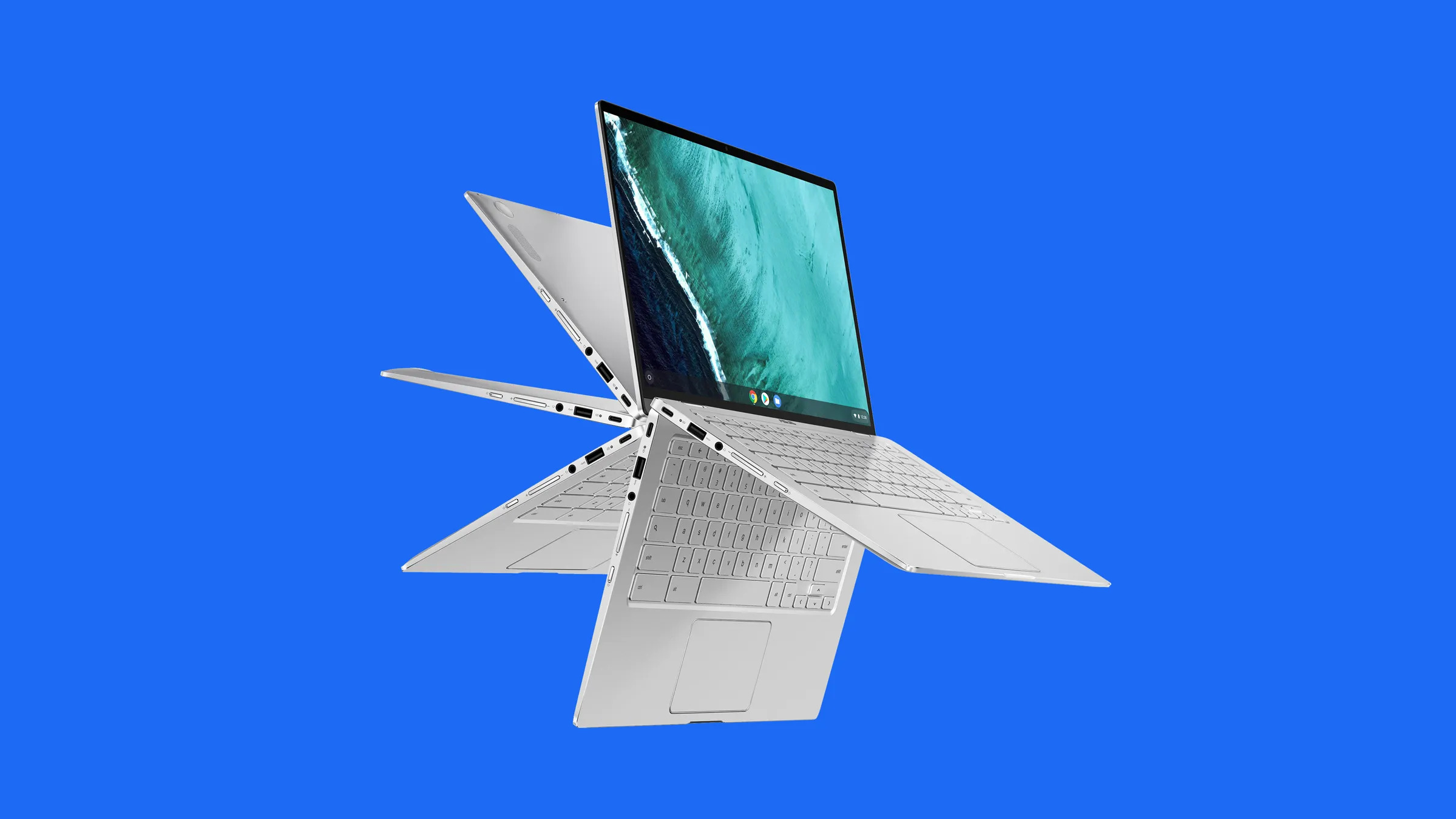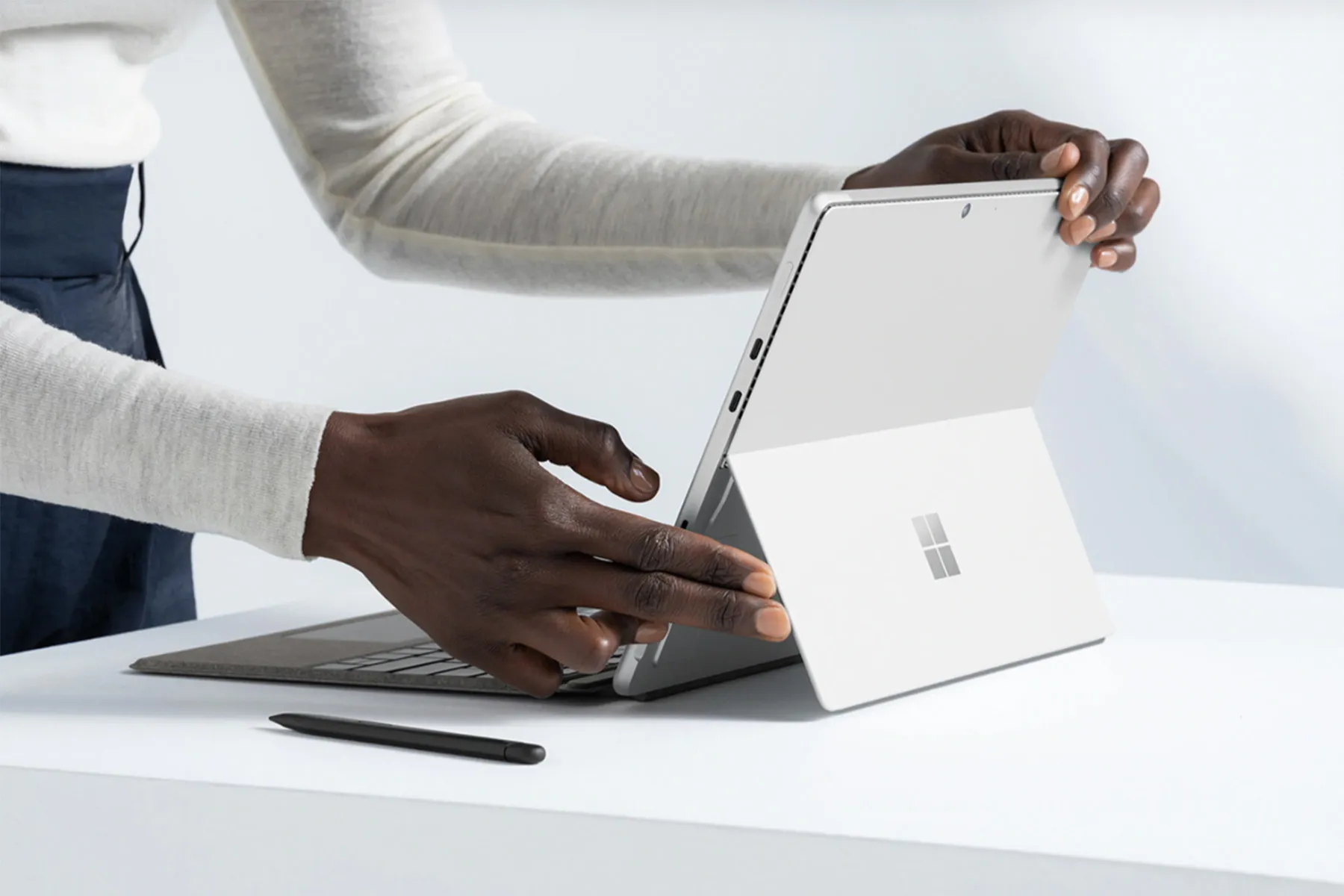Introduction
Welcome to the world of convertible laptops, where versatile functionality meets sleek design. In today’s fast-paced digital age, having a device that can adapt to different needs and situations is becoming increasingly important. Whether you are a student, a professional on the go, or simply someone who values convenience and versatility, a convertible laptop may be the perfect solution for you.
A convertible laptop, also known as a 2-in-1 laptop or a hybrid laptop, is a device that combines the functionality of a traditional laptop with the convenience and flexibility of a tablet. It allows you to switch seamlessly between laptop and tablet modes, with the ability to transform from a laptop with a keyboard and trackpad to a tablet with a touch screen interface. This versatility enables you to use your convertible laptop for a wide range of tasks, from typing documents and browsing the web to drawing, taking notes, and watching movies.
One of the key features that sets convertible laptops apart from their traditional counterparts is their ability to be used in multiple modes. In addition to laptop and tablet modes, many convertible laptops also offer a tent mode, where the device is propped up like a tent, and a stand mode, where the keyboard is flipped back and the screen is angled for comfortable multimedia viewing.
There are numerous benefits to owning a convertible laptop. Firstly, their portability makes them ideal for those who are always on the move. With a convertible laptop, you have the convenience of a lightweight and compact device that can be easily carried in a bag or backpack. Secondly, the ability to switch between laptop and tablet modes gives you the flexibility to adapt to different activities and environments. Whether you need to work on a spreadsheet, give a presentation, or simply relax and enjoy some entertainment, your convertible laptop can effortlessly transform to suit your needs.
Another advantage of convertible laptops is their touch screen capability. This allows for intuitive and interactive navigation, making tasks such as scrolling, zooming, and accessing apps much smoother and more natural. Additionally, convertible laptops often come with stylus support, enabling you to write, draw, and make annotations directly on the screen, further enhancing the versatility and productivity of the device.
In the following sections, we will delve deeper into the world of convertible laptops and explore the different types available, as well as the various factors to consider when choosing one. Whether you are considering your first convertible laptop or looking to upgrade to a newer model, this guide will provide you with the knowledge you need to make an informed decision.
Definition and Overview
Before we dive into the intricacies of convertible laptops, let’s start with a clear definition and overview of what they are. As mentioned earlier, a convertible laptop is a hybrid device that combines the features of a traditional laptop and a tablet. It offers the convenience of a laptop’s keyboard and trackpad, as well as the flexibility of a tablet’s touch screen interface.
What sets convertible laptops apart from other laptop categories is their ability to switch between different modes. The primary modes of a convertible laptop include:
- Laptop Mode: In this mode, the device functions as a standard laptop with the screen upright and the keyboard and trackpad accessible for typing and navigation.
- Tablet Mode: In tablet mode, the keyboard is usually flipped back behind the screen or detached altogether, allowing you to use the device as a standalone tablet with touch screen navigation.
- Tent Mode: Tent mode is achieved by bending the laptop at its hinges, creating an inverted “V” shape. This mode is particularly useful for activities like watching videos or participating in video conferences, as it provides a stable stand for the device.
- Stand Mode: Stand mode is similar to tent mode but with the screen fully open and flattened on a surface, providing an angled display for multimedia consumption.
Convertible laptops are powered by various operating systems, with Windows, macOS, and ChromeOS being the most popular choices. Each operating system offers its own set of features and compatibility with different software, so it’s essential to consider your specific needs and preferences when choosing a convertible laptop.
As the demand for convertible laptops has risen, manufacturers have introduced different variations to cater to diverse user requirements. Two common types of convertible laptops include:
- Detachable Convertible: This type of convertible laptop has a detachable keyboard that can be completely separated from the screen, essentially transforming it into a standalone tablet. This design offers the greatest flexibility but may sacrifice some keyboard functionality.
- Convertible with 360-Degree Hinge: In this design, the screen and keyboard are connected by a sturdy hinge that allows the screen to rotate a full 360 degrees. This enables seamless transitions between laptop, tablet, and other modes, with no need to detach any components.
In the next sections, we will explore the pros and cons of owning a convertible laptop, as well as important factors to consider when choosing one. Remember, selecting the right convertible laptop depends on your unique needs and preferences, so it’s crucial to carefully evaluate each aspect before making a decision.
Benefits of Owning a Convertible Laptop
Owning a convertible laptop comes with a host of benefits that make it an appealing choice for a wide range of users. Let’s explore some of the advantages of having this versatile device:
1. Versatility: The main advantage of a convertible laptop is its ability to adapt to different needs and scenarios. Whether you need to type a document, use touch screen capabilities for drawing or note-taking, or simply relax and browse the Internet in tablet mode, a convertible laptop has you covered. It eliminates the need to carry multiple devices, allowing you to seamlessly switch between laptop and tablet functionality with ease.
2. Portability: Convertible laptops are designed with portability in mind. They are typically lightweight and slim, making them easy to carry in your bag or backpack. Whether you’re a student rushing between classes, a professional traveling for work, or a digital nomad always on the go, a convertible laptop offers the convenience of having a powerful device at your fingertips, wherever you may be.
3. Touch Screen Interaction: Unlike traditional laptops, convertible laptops come with touch screen functionality. This brings a whole new level of interactivity and intuitive navigation to your computing experience. With a simple tap, swipe, or pinch, you can effortlessly scroll through web pages, zoom in and out of images, and interact with apps without the need for a mouse or trackpad.
4. Stylus Support: Many convertible laptops also come with stylus support, allowing you to unleash your creativity and productivity. With a stylus, you can jot down notes, sketch ideas, edit documents, and make precise annotations directly on the screen. This feature is particularly beneficial for artists, designers, students, and anyone who values the tactile experience of pen and paper.
5. Flexibility in Viewing Modes: Convertible laptops offer different viewing modes, such as tent mode and stand mode. These modes allow you to adjust the screen angle to find the most comfortable position for various activities. Whether you’re giving a presentation, watching a movie, or working on a project, you can find the perfect screen orientation to suit your needs.
6. Enhanced Productivity: Convertible laptops provide a convenient platform for productivity on the go. The combination of a physical keyboard, touch screen, and optional stylus gives you a range of input methods to choose from, enabling you to work efficiently and comfortably. Whether you’re typing a report, collaborating on a document, or multitasking between different apps, a convertible laptop can boost your productivity and help you get the job done.
7. Extended Battery Life: While this benefit may vary depending on the specific model, many convertible laptops are designed to have long-lasting battery life. This is especially important for individuals who are frequently on the move and may not have access to a power source for extended periods. With a convertible laptop, you can work, play, and stay connected for hours without worrying about running out of battery.
With these outstanding benefits, it’s clear why convertible laptops have gained popularity among users looking for a versatile and portable computing device. In the next sections, we will explore different types of convertible laptops and compare them to traditional laptops to help you make an informed decision.
Different Types of Convertible Laptops
When it comes to convertible laptops, there are various types available on the market, each with its own unique design and functionality. Here are the main types of convertible laptops you can choose from:
1. Detachable Convertible: As the name suggests, detachable convertibles consist of two separate components – a tablet screen and a detachable keyboard. The tablet part is essentially a standalone device, allowing you to use it independently by detaching the keyboard. This type offers maximum flexibility since you can use it as a traditional laptop or a tablet depending on your needs. However, it’s worth noting that the keyboard attachment may be smaller and sacrifice some tactile feedback compared to a non-detachable keyboard.
2. Convertible with 360-Degree Hinge: This type of convertible laptop features a 360-degree hinge that allows the screen to rotate all the way around. The hinge is designed to be sturdy and flexible, allowing you to transition smoothly between different modes – laptop, tablet, tent, and stand. With this design, you don’t need to detach any components to switch between modes, making it a convenient option for those who frequently switch from laptop to tablet and vice versa.
3. Convertible with Slide-Out Keyboard: Some convertible laptops come with a slide-out keyboard mechanism. In this design, the screen can be slid forward to reveal the integrated keyboard beneath it. This type of convertible laptop offers a seamless transition between laptop and tablet modes, with the advantage of having a full-sized keyboard when needed. However, it’s worth noting that slide-out keyboards are less common and may have limited availability compared to other types.
4. Convertible with Reversible Screen: This type of convertible laptop features a reversible screen that can be flipped and folded all the way back onto the keyboard. This design allows you to use the device in multiple modes, including tablet, tent, and stand, while still having access to the keyboard and trackpad when required. Reversible screen convertibles offer versatility and convenience, making them a popular choice among users who prioritize flexibility.
5. Convertible Gaming Laptop: Gaming enthusiasts can also find convertible laptops designed specifically for a gaming experience. These laptops often feature powerful processors, dedicated graphics cards, high-resolution displays, and other gaming-focused features. While the primary purpose of gaming convertibles is to deliver an immersive gaming experience, they also offer the flexibility of switching to tablet or other modes for everyday use.
These are just a few examples of the different types of convertible laptops available. It’s important to consider your specific needs, preferences, and budget when choosing the right type for you. Each type has its own advantages and limitations, so take the time to evaluate which design aligns best with your usage requirements.
In the next section, we will compare the pros and cons of convertible laptops versus traditional laptops to help you determine which option is most suitable for your computing needs.
Convertible Laptop vs. Traditional Laptop: Pros and Cons
When considering a new laptop, it’s important to weigh the pros and cons of convertible laptops versus traditional laptops. Each type has its own set of advantages and limitations, and understanding these differences will help you make an informed decision. Let’s explore the pros and cons of each:
Convertible Laptop:
Pros:
- Versatility: The ability to switch between laptop and tablet modes offers increased flexibility for different tasks and environments.
- Portability: Convertible laptops are typically lightweight and slim, making them easy to carry and ideal for users who are frequently on the go.
- Touch Screen Functionality: With a touch screen interface, convertible laptops provide a more interactive and intuitive way to navigate and interact with content.
- Stylus Support: Many convertible laptops come with stylus support, allowing for precise and creative input through handwriting, drawing, and annotation.
- Flexible Viewing Modes: Convertible laptops offer various modes, such as tent and stand, providing ergonomic options for different activities like watching videos or giving presentations.
Cons:
- Slightly Thicker: Due to the mechanism required for the screen rotation or detachable keyboard, convertible laptops may be slightly thicker than traditional laptops.
- Keyboard Ergonomics: Some convertible laptops have smaller or flatter keyboards, which may not offer the same typing comfort as traditional laptops with full-sized keyboards.
- Price: Convertible laptops often come with a higher price tag compared to traditional laptops with similar specifications, due to the added versatility and touch screen technology.
- Battery Life: Depending on the specific model, convertible laptops may have slightly lower battery life compared to traditional laptops due to the additional power required for touch screen functionality and versatile modes.
Traditional Laptop:
Pros:
- Dedicated Keyboard and Trackpad: Traditional laptops offer a more spacious and tactile keyboard and trackpad, which can enhance typing efficiency and precision.
- Lighter Weight: Without the additional mechanisms required for convertible laptops, traditional laptops tend to be lighter in weight and more portable.
- Lower Price Point: Traditional laptops generally offer a wider range of options and price points, making them more accessible for budget-conscious users.
- Extended Battery Life: Traditional laptops often have longer battery life compared to convertible laptops, as they do not require power for touch screen functionality or versatile modes.
Cons:
- Less Flexibility: Unlike convertible laptops, traditional laptops lack the ability to switch between different modes, limiting their adaptability for different tasks and scenarios.
- Lack of Touch Screen: Traditional laptops do not have touch screen functionality, which can make certain interactions and navigation less intuitive compared to convertible laptops.
- Limited Stylus Support: While some traditional laptops may offer stylus support, it is not as common or seamlessly integrated as in convertible laptops.
Consider your specific needs and preferences to determine which type of laptop is best suited for you. If versatility, touch screen interaction, and flexible modes are important to you, a convertible laptop may be the ideal choice. On the other hand, if a traditional laptop with a dedicated keyboard, lightweight design, and longer battery life aligns better with your needs, then that may be the way to go.
In the next section, we will explore the factors to consider when choosing a convertible laptop to help you make the right decision.
Factors to Consider When Choosing a Convertible Laptop
Choosing the right convertible laptop requires careful consideration of various factors to ensure that it meets your specific needs and preferences. Here are some essential factors to keep in mind when making your decision:
1. Operating System: Consider the operating system that best aligns with your needs and familiarity. Windows, macOS, and ChromeOS are the main options available for convertible laptops, each offering different features, software compatibility, and user interfaces.
2. Performance: Pay attention to the specifications of the convertible laptop, including the processor, RAM, storage capacity, and graphics capabilities. Ensure that the device has enough power to handle your intended tasks, whether it’s basic productivity, multimedia editing, or gaming.
3. Display: The display quality is important, especially for touch screen interaction and visual clarity. Consider factors such as screen size, resolution, color accuracy, brightness, and viewing angles to find a display that suits your preferences and needs.
4. Form Factor and Design: Look for a form factor and design that meets your usage requirements. Decide whether you prefer a detachable or 360-degree hinge design, take note of the dimensions and weight for portability, and choose a build material that feels durable and comfortable to hold.
5. Battery Life: Evaluate the battery life of the convertible laptop, especially if you plan to use it on the go or in situations where power outlets may not be readily available. Look for a device that offers sufficient battery endurance for your specific usage patterns.
6. Keyboard and Trackpad: Consider the keyboard and trackpad design and ergonomics, ensuring that they are comfortable and responsive for extended typing sessions. Look for features such as backlit keys if you frequently work in low-light environments.
7. Stylus Support: If you anticipate using a stylus for drawing, note-taking, or other creative tasks, ensure that the convertible laptop supports an active stylus. Look for models that include a stylus or have compatibility with popular stylus brands.
8. Connectivity: Check the connectivity options available on the device, including USB ports, HDMI, headphone jack, and any other ports or slots you may require. Consider wireless connectivity options such as Wi-Fi and Bluetooth for seamless connectivity with other devices.
9. Storage and Expandability: Evaluate the available storage capacity of the convertible laptop and consider whether it can be expanded through options such as SD card slots or external storage solutions. Ensure that the device offers enough storage for your files, applications, and media.
10. Price: Determine your budget and find a convertible laptop that offers a balance between the features and specifications you need and the price you are willing to pay. Consider any additional costs for accessories such as stylus or protective cases.
11. Reviews and User Feedback: Lastly, take the time to read reviews and user feedback on different models to gain insights into real-world experiences and possible issues. This can help you make a more informed decision and identify any potential drawbacks or limitations.
By considering these factors, you can select a convertible laptop that best suits your requirements and provides an enjoyable and productive computing experience. In the next section, we will explore some popular brands and models of convertible laptops to help you with your research and comparison.
Popular Brands and Models of Convertible Laptops
When it comes to convertible laptops, several brands have established themselves as leaders in the market, offering a wide range of models with various features and specifications. Here are some popular brands and their notable convertible laptop models:
1. Lenovo Yoga: Lenovo’s Yoga series is renowned for its versatile 2-in-1 devices. The Yoga C940 and Yoga C740 models feature 360-degree hinges, high-quality displays, powerful processors, and sleek designs. They offer a seamless transition between laptop and tablet modes and are popular among users looking for a premium convertible laptop.
2. Microsoft Surface: Microsoft’s Surface lineup includes some of the most popular and well-regarded convertible laptops. The Surface Pro and Surface Book series offer detachable keyboards, high-resolution touch screens, and excellent stylus support. They are favored by professionals, creatives, and students alike for their performance, build quality, and portability.
3. Dell XPS: Dell’s XPS lineup features convertible laptops known for their sleek designs and powerful performance. The XPS 13 2-in-1 and XPS 15 2-in-1 offer stunning displays, Intel processors, and long battery life. These devices are popular choices for those seeking a combination of premium build quality and outstanding performance.
4. HP Spectre: HP’s Spectre series is synonymous with elegance and performance. The Spectre x360 models are highly regarded for their slim designs, vibrant displays, long battery life, and reliable performance. With a 360-degree hinge and a focus on aesthetics, the HP Spectre laptops are a compelling choice for style-conscious individuals.
5. ASUS ZenBook Flip: ASUS ZenBook Flip laptops offer a combination of style, performance, and versatility. Models like the ZenBook Flip S and ZenBook Flip 14 feature 360-degree hinges, slim profiles, powerful processors, and excellent displays. They are popular among users who prioritize a balance between portability, functionality, and affordability.
6. Acer Spin: Acer’s Spin series provides a range of affordable and feature-packed convertible laptops. Models like the Acer Spin 5 and Spin 3 offer 360-degree hinges, touch screens, solid performance, and attractive price points. Acer Spin laptops are favored by budget-conscious users seeking convertible laptops with decent specifications.
7. Samsung Galaxy Book Flex: Samsung’s Galaxy Book Flex series is known for its stunning AMOLED displays, long battery life, and premium features. The Galaxy Book Flex and Galaxy Book Flex α models offer 360-degree hinges, built-in stylus compatibility, and sleek designs. These devices are a popular choice for users in need of a high-quality convertible laptop with standout display technology.
These are just a few examples of popular brands and their notable models in the convertible laptop category. It’s important to research and compare different brands and models based on your specific requirements, budget, and preferences. Reading reviews, checking for reliability, considering after-sales support, and consulting with technology experts can further help in making an informed choice.
In the next section, we will explore how to effectively use a convertible laptop in tablet mode, showcasing the various ways you can maximize your productivity and enjoyment.
How to Use a Convertible Laptop in Tablet Mode
One of the key features of a convertible laptop is the ability to use it in tablet mode, providing a more immersive and intuitive touch screen experience. Here are some tips on how to effectively use your convertible laptop in tablet mode:
1. Navigation and Gestures: Take advantage of touch screen gestures to navigate through your convertible laptop. Use swiping motions to scroll through webpages, documents, and lists. Pinch or spread your fingers to zoom in or out. Tap with one finger to select an item, and use two fingers for right-click functionality.
2. On-Screen Keyboard: When in tablet mode, the physical keyboard is usually disabled or folded back, and an on-screen keyboard appears automatically. Familiarize yourself with using the on-screen keyboard for typing emails, messages, or taking notes. You can also adjust the keyboard settings to make it more comfortable, such as resizing or splitting it for easier thumb typing.
3. Using Stylus or Pen Input: If your convertible laptop supports stylus or pen input, utilize this feature for more precise drawing, sketching, note-taking, or annotating documents. Experiment with different pressure levels and tilt sensitivity to explore the full potential of the stylus. Many applications, such as drawing programs or note-taking apps, offer additional features specifically designed for stylus input.
4. Optimizing Tablet-Friendly Apps: Explore and install tablet-optimized applications from app stores or marketplaces. These apps are designed to take full advantage of touch screen functionality and may offer enhanced features and tailored user interfaces for tablet usage. Examples include photo editing, drawing, note-taking, and entertainment apps.
5. Customizing the Start Screen or Home Screen: Convertible laptops running Windows or ChromeOS often have a tablet-specific Start Screen or Home Screen. Customize these screens by arranging your frequently used apps and widgets for quick and easy access. Consider grouping similar apps together or pinning your favorite apps to the main screen for convenience.
6. Gestures for Multitasking: Take advantage of multitasking gestures to work more efficiently. For example, on Windows devices, swipe from the left edge to switch between recent apps, and swipe from the right to access the Action Center. On ChromeOS, swipe up from the bottom of the screen to see all open windows and swipe down to return to the previous app or screen.
7. Screen Orientation Lock: Some convertible laptops automatically adjust the screen orientation based on the device position, while others allow you to manually change it. Lock the screen orientation if needed, especially when reading or watching videos to prevent accidental screen rotations.
8. Utilizing Voice and Handwriting Recognition: Convertible laptops often come with voice recognition and handwriting recognition capabilities. Instead of typing, consider using these features for tasks such as dictating documents or converting your handwritten notes into digital text.
9. App-Specific Features: Explore the features offered by applications specifically designed for touch screens. For example, many web browsers support touch-based gestures for tab management or navigation. Drawing or note-taking apps may have additional options for brush sizes, colors, or ink effects.
10. Protecting and Cleaning the Screen: Convertible laptops rely heavily on the touch screen for input. To ensure optimal performance and longevity, keep the screen clean by using a microfiber cloth or a screen cleaner designed for electronics. Consider using screen protectors to minimize the risk of scratches or smudges.
By following these tips, you can fully utilize the tablet mode of your convertible laptop and enjoy a seamless touch screen experience. Remember to experiment with different apps, gestures, and input methods to find the most efficient and comfortable workflow for your needs.
In the next section, we will share some helpful tips for maximizing the performance of your convertible laptop.
Tips for Maximizing the Performance of your Convertible Laptop
To ensure that your convertible laptop performs at its best, it’s important to optimize its settings and maintain its hardware regularly. Here are some tips to help you maximize the performance of your convertible laptop:
1. Keep Your System Updated: Regularly check for operating system updates and install them to benefit from improved performance, security patches, and bug fixes. Keeping your system up to date will ensure optimal functionality and compatibility with the latest software.
2. Minimize Startup Programs: Disable unnecessary programs from launching at startup. This reduces the load on your system’s resources, allowing it to boot up faster and allocate more memory and processing power to the tasks you need to perform.
3. Manage Background Processes: Monitor and close unnecessary background processes and applications running in the background. This frees up system resources and ensures that your convertible laptop can focus on the tasks you’re actively working on.
4. Optimize Power Settings: Adjust your power settings to balance performance and battery life. Use the “Balanced” or “Recommended” power plan for a good balance between energy efficiency and speed. Customize power settings to your preferences, including screen timeouts and sleep settings.
5. Clear Cache and Temporary Files: Regularly clear your cache, temporary files, and browser history. Accumulated temporary files can slow down your convertible laptop over time. Use built-in tools or third-party software to perform regular cleanups.
6. Uninstall Unused Programs: Remove any unnecessary or unused applications from your convertible laptop. This frees up storage space and reduces background processes, resulting in improved overall system performance.
7. Regularly Update Drivers: Update your device drivers to the latest versions provided by the manufacturer. The latest drivers often include bug fixes, compatibility improvements, and performance optimizations.
8. Remove Bloatware: Uninstall any pre-installed software or unnecessary applications that came with your convertible laptop. Bloatware can consume system resources and affect overall performance.
9. Utilize Antivirus Software: Install and regularly update reputable antivirus software to protect your convertible laptop from malware and ensure stable and secure performance. Run regular scans to detect and remove any potential threats.
10. Keep Your Convertible Laptop Clean: Keep your convertible laptop physically clean by regularly removing dust from the keyboard, vents, and ports. Use compressed air or a soft brush to prevent dust buildup, as heat and dust can negatively impact performance.
11. Manage Storage Space: Regularly clean up and organize your storage by deleting unnecessary files, archiving old documents, or moving files to external storage devices. This helps prevent your system from becoming cluttered and helps maintain optimal performance.
12. Perform Regular Disk Defragmentation: If your convertible laptop has a traditional hard disk drive (HDD), consider performing regular disk defragmentation. Defragmenting rearranges data on the hard drive, improving data access speed and overall system performance.
13. Consider Hardware Upgrades: If your convertible laptop is struggling to meet your performance needs, adding more RAM or upgrading to a solid-state drive (SSD) can significantly boost its speed and responsiveness.
By following these tips, you can ensure that your convertible laptop operates at its best performance, allowing you to work, play, and enjoy multimedia with efficiency and ease.
In the concluding section, we will briefly recap the key points discussed and emphasize the importance of considering these factors when choosing and using a convertible laptop.
Conclusion
Convertible laptops offer the best of both worlds, combining the functionality of a traditional laptop with the flexibility and convenience of a tablet. With the ability to seamlessly transition between laptop and tablet modes, these devices provide versatility, portability, and intuitive touch screen interaction.
When choosing a convertible laptop, consider factors such as the operating system, performance, display quality, form factor, battery life, and price. Take into account your specific needs, whether it’s for work, creativity, entertainment, or a combination of tasks.
Popular brands such as Lenovo, Microsoft, Dell, HP, ASUS, and Acer offer a range of convertible laptop models, each with its own unique features and design elements. Research and compare different options to find the one that best suits your requirements and budget.
Once you have your convertible laptop, make the most of its capabilities by effectively using tablet mode. Familiarize yourself with touch screen navigation, on-screen keyboards, stylus input, and tablet-optimized applications. Customize your start screen or home screen, utilize gestures for multitasking, and protect and clean the screen for optimal performance.
Additionally, optimize the performance of your convertible laptop by keeping your system updated, minimizing startup programs, managing background processes, and clearing cache and temporary files. Regularly update drivers, uninstall unwanted programs and bloatware, utilize antivirus software, maintain cleanliness, manage storage space, and consider hardware upgrades if necessary.
By considering these factors and implementing the tips for maximizing performance, you can ensure that your convertible laptop meets your expectations and provides an enjoyable and productive computing experience.
Now that you have a better understanding of what convertible laptops have to offer, take the time to explore the available options, compare specifications, read reviews, and make an informed decision. Choose the convertible laptop that aligns with your needs and preferences, and get ready to embrace the versatility and convenience of this amazing device.









